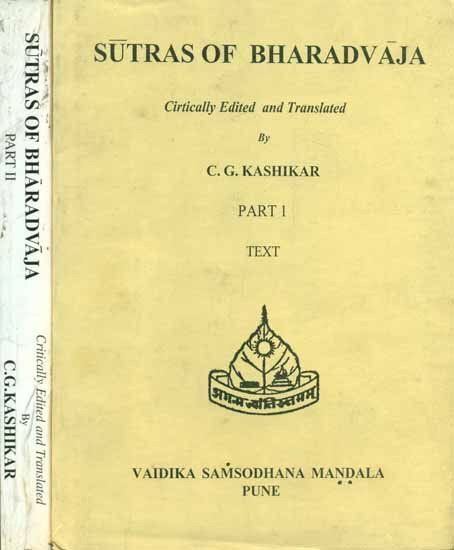Bharadvaja-srauta-sutra
by C. G. Kashikar | 1964 | 166,530 words
The English translation of the Bharadvaja-Srauta-Sutra, representing some of the oldest texts on Hindu rituals and rites of passages, dating to at least the 1st millennium BCE. The term Srautasutra refers to a class of Sanskrit Sutra literature dealing with ceremonies based on the Brahmana divisions of the Veda (Sruti). They include Vedic rituals r...
Praśna 10, Kaṇḍikā 3
1. A square shed should be erected with its rafters ending towards the east (prācīnavaṃśa) and with the front portion being higher.[1]
2. It should have doors towards the (four) quarters. There should be a fifth door in the north-eastern corner.
3. According to some teachers,[2] openings should be kept in the corners.
4. In that shed, the Adhvaryu should mentally go through the saptahotṛ formula,[3] and offer an oblation of clarified butter on the Āhavanīya fire with the graha portion of that formula.
5. He should perform the Dīkṣaṇīyeṣṭi.
6. He should pour out paddy fora cake on eleven potsherds for Agni-Viṣṇu, or for rice to be cooked in ghee for Agni-Viṣṇu.[4]
7. The Dīkṣaṇīyeṣṭi should be concluded with the Patnīsaṃyāja offerings.[5]
8. All rites preceding the Agniṣomīya animal-sacrifice[6] should be performed with the mantras recited to oneself.
9. There should be no anvāhārya cooked rice in the Dīkṣaṇīyeṣṭi.
10. Towards the north of the prāgvaṃśa, in a place enclosed on all sides, the sacrificer should have his hair and beard shaved.
11. The Adhvaryu should apply water to the region above the right ear of the sacrificer with the formula, “May the waters wet thee for life, prolonged life, and glory.”[7]
12. He should divide his hair with a three-striped quill of a porcupine, and hold three clusters of darbha-blades with their ends pointing upwards, with the formula, “O plant, do thou protect him.”[8]
13. With the formula, “O Knife, do thou not injure him,”[9] he should place the knife on the darbha-blades.
14. He should cut them with the formula, “Obedient to gods, I shave these (hair).”[10]
15. The sacrificer should murmur the formula, “May I accomplish the subsequent (rites) in a safe manner.”[11]
16. He should cause the beard to be shaved first, then the armpits, and then the hair. So is it said.
17. He should cleanse his teeth by means of a tooth-cleaner of udumbara without causing bleeding.
18. After having cleansed his teeth, he should cause his nails to be (pared so that they are) inside1 (the tips of the fingers).
1. By the word abhyantaram CALAND in his note on Āpastamba-śrauta-sūtra X.5.II, understands that each nail is to be pared first from one side and then from the other. This however, does not seem to be probable and practicable. Also compare the meaning of this word in Āpastamba-śrauta-sūtra XV.6.l5;7.3.
19. First of the left (hand) beginning with the smallest finger. Then of the right hand.
20. First of the hands, then of the feet.
21. He should bathe at a bathing place which is covered with grass and is full of avakā (Blyxa-octandra) plants.
22. (The water at the bathing place) should be still and constant.
Footnotes and references:
[1]:
Āpastamba-śrauta-sūtra X.2.9-3.3 prescribes the formal begging for the place for sacrifice.
[3]:
Taittirīya-āraṇyaka III.l.
[4]:
According to Āpastamba-śrauta-sūtra X.4.2-4, he should offer either a cake or cooked rice according to the specific desire. According to some teachers, rice cooked in ghee should be offered to Aditi for a sacrificer desirous of offspring and cattle.
[5]:
Āpastamba-śrauta-sūtra X.4.6 mentions two views of the Ācāryas: according to one, the construction of the prācīnavaṃśa should precede the performance of the Dīkṣaṇīyeṣṭi; according to the other, it should follow the latter.
[6]:
XII.16.1 ff.
[7]:
Taittirīya-saṃhitā I.2.1.1.
[8]:
Taittirīya-saṃhitā I.2.1.1.
[9]:
Taittirīya-saṃhitā I.2.1 1..
[10]:
Taittirīya-saṃhitā I.2.1.1.
[11]:
Taittirīya-saṃhitā I.2.1.1.
